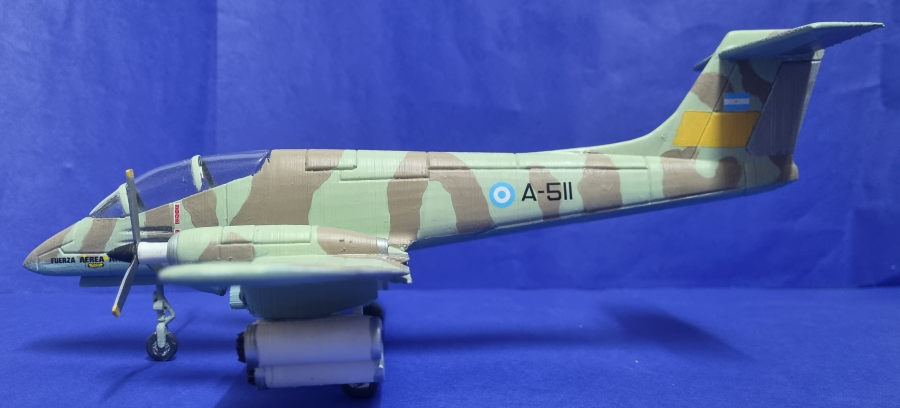
Kosmosur 3D 1/48 IA.58 Pucara
| KIT #: | |
| PRICE: | 18$ |
| DECALS: | None provided |
| REVIEWER: | Francisco Santoro |
| NOTES: | Aerocalcas decals |

| HISTORY |
From the instructions of the Special Hobby kit: "In the mid 1960s the Argentinian Air Force issued a specification for a new ground attack aircraft that would be capable of providing close air support for the Army. The requierement was handed over to the Air Force owned Fábrica Militar de Aviones (FMA).
The proposal formally presented to the Air Force on
January 29th 1968 was for a twin turboprop, two seat, low wing and T-tailed
aircraft that would be capable of low and slow flight in order to accomplish its
requiered mission. By August 20th, the first prototype made its maiden flight,
powered by Garret TPE-331-U303 engines. Two more prototypes would follow, but
problems with the American engines and some strained relations with the US led
to the adoption of French Turbomeca Aztazou engines. Shortly after, it was s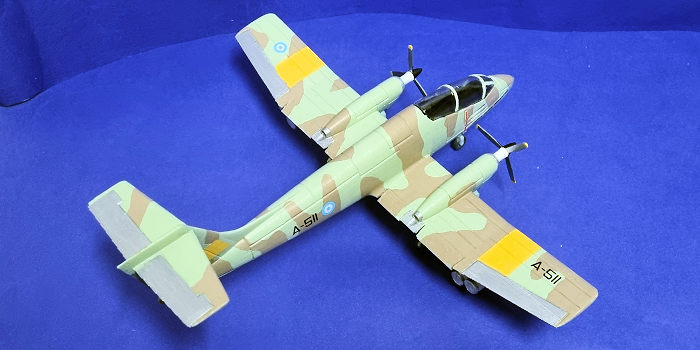 uggested
by the wife of one of the test pilots, 1st Lieutenant Digier, that the aircraft
be named after the local Quechua indina tribe word for "Fortress." The name
Pucará was accepted. The first production example flew for the first time on
November 14th 1974, by which time a Pucará Task Group was preparing the base
they were destined to operate from: Base Aérea Militar Reconquista, in the
province of Santa Fé.
uggested
by the wife of one of the test pilots, 1st Lieutenant Digier, that the aircraft
be named after the local Quechua indina tribe word for "Fortress." The name
Pucará was accepted. The first production example flew for the first time on
November 14th 1974, by which time a Pucará Task Group was preparing the base
they were destined to operate from: Base Aérea Militar Reconquista, in the
province of Santa Fé.
By the time the first two Pucarás, A-501 and A-502 arrived at the base on August 27th 1975, the country had been steadily suffering from the infiltration of communist guerrillas, mainly from neighbouring Bolivia, in the northern border areas of Argentina. The Argentinian Army managed to get authorization to mount Operación Independencia to remove the threat from Argentinian soil. During the successful operation, four Pucarás operated in support of the Army from the Military Aviation School in the province of Córdoba.
Tension with neighbouring Chile at the end of 1978 saw the Air Force deploy all of its Pucarás to two bases in the Patagonia: BAM Puerto Santa Cruz in the province of Santa Cruz, and BAM Fuerte General Roca in the province of Río Negro. Fortunately common sense prevailed and the aircraft returned to normal status shortly thereafter, but the crisis served to prove that both aircraft and personnel could be considered operational.
By 1982, the military goverment that had overthrown
the previous inept civilian government was in decline and the Army and Navy
commanders organised the taking of the Malvinas Islands to improve their image,
never anticipating that Great Britain would mount a huge effort to retake the
islands. No matter how just one may consider the cause, it's very sad that such
conflict could have ever taken place, and the Air Force was forced by the events
to provide full support for the ensuing operations. After the taking of the
islands on April 2nd 1982, it was found that few combat aircraft could be sent
to operate from them after the capture, due to inadequate facilities and
runways. However, the Pucará was found to be one of them due to its ruggedness
and strong undercarriage. In peacetime service, the Pucará was always left in
natural metal, but all aircra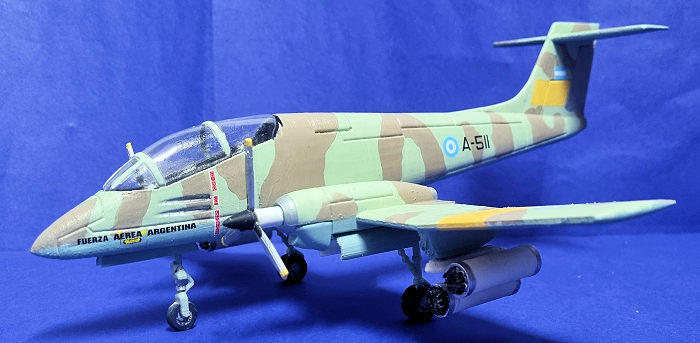 ft
operating in the war theatre were ordered to be camouflaged, so they received a
coat of light brown, light green and light blue. Only three Pucarás were
actually shot down during combat: One by a Stinger missile, one by a Sea
Harrier, and the other by small arms fire.
ft
operating in the war theatre were ordered to be camouflaged, so they received a
coat of light brown, light green and light blue. Only three Pucarás were
actually shot down during combat: One by a Stinger missile, one by a Sea
Harrier, and the other by small arms fire.
Foreign operators are the Uruguayan Air Force and the Sri Lankan Air Force, the latter seeing combat themselves against Tamil rebels and suffered the loss of two of its Pucarás. Colombia is returning the three Pucarás that were donated by the Argentinina government in 1989, due to lack of spares and funds to maintain such small force.
Production ended in 1988, reaching 108 aircraft and three prototypes. A few aircraft were delivered to the Air Force as late as 1996 however, with three aircraft still remaining undelivered due to lack of funds. Taking this into account, there's no doubt the Pucará will remain an Argentinian Air Force asset for years to come."
Further history by me: The Pucará was retired from service in 2019, leaving the air force in even more bare bones than before. The latest version, the Fénix, is still under trial as an ISR platform (Intelligence, Surveillance and Reconnaissance).
| THE KIT |
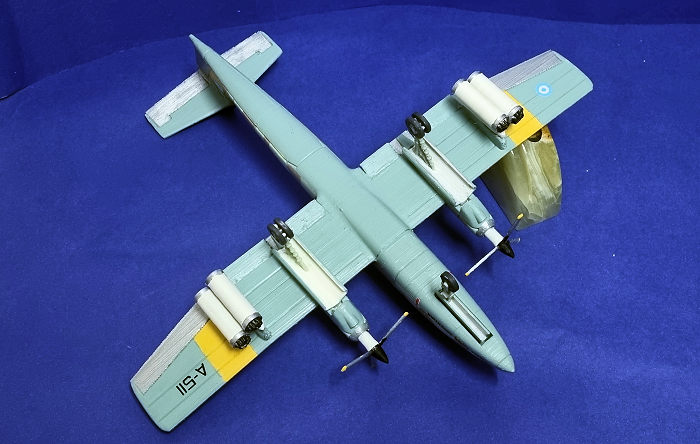 This kit is
from Kosmosur 3D, an Argentinian manufacturer that has done several planes that
served with the FAA. Most of the planes are in 1:48, and so is this one. The kit
itself is divided in three fuselage halves (middle section with the wings),
propellers, landing gear bays, wheels, cockpit, underwing rocket pods and
vacuformed canopy. All the parts are printed in white PLA plastic.
This kit is
from Kosmosur 3D, an Argentinian manufacturer that has done several planes that
served with the FAA. Most of the planes are in 1:48, and so is this one. The kit
itself is divided in three fuselage halves (middle section with the wings),
propellers, landing gear bays, wheels, cockpit, underwing rocket pods and
vacuformed canopy. All the parts are printed in white PLA plastic.
If you ask yourself how this kit compares to the Kinetic release, I´d say you can´t do that. One is years ahead of the other, with the regular plastic kit being all around better. The 3d printed offer is valid for those who don´t want to spend over 150$ on a kit that should be much cheaper. The “argentinizable” trend is in full swing with this one (Argentiniazable: Models, especially aircraft, that served in the Fuerza Aérea Argentina or Armada during Malvinas. Models of earlier years are better priced, but still expensive).
The kit doesn´t come with decals, so I bought mine directly from Aerocalcas (which are of better quality that Condor Decals). I paid 3700ARS (15$) for this set, which came with markings for a regular Pucará and a Delta one (in low visibility grey).
| CONSTRUCTION |
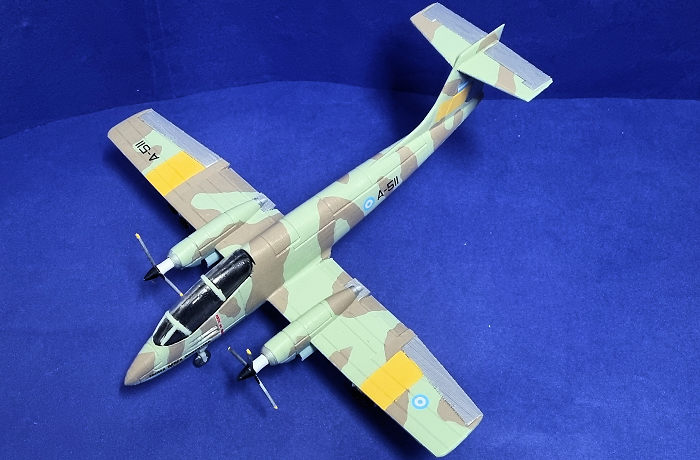 I started
by gluing the three fuselage halves with epoxy glue and taping them together.
After waiting for half a day, I filled the unions with Vallejo´s Plastic Putty
(useful only for superficial gaps) and superglue.
I started
by gluing the three fuselage halves with epoxy glue and taping them together.
After waiting for half a day, I filled the unions with Vallejo´s Plastic Putty
(useful only for superficial gaps) and superglue.
While the CA was drying, I spent some time painting the props (Revell Silver 90 with Yellow 15 tips and 08 Matt Black nose cone and de-icing boots on the base of the prop). The landing gear Wells were painted Revell Matt 05 White with Revell 59 Duck Egg Blue struts and Silver 90 oleos. Wheels were painted with 05 Matt White wheels and 78 Tank Grey tyres. The wheels were then glued to the landing gear struts after the paint had gone off.
Back to the airframe. The Pucará has most of its structure behind the main landing gear, and there wasn´t enough space to add weight as forward as possible. So I chose to add a large 60 gram weight inside the cockpit, leaving the pilots out. The inside of the cockpit was painted Revell 08 Matt Black. I then got an idea, to cut and drop the flaps as in the Kinetic kit. I used my Xacto knife to score on the union between the wings and the flaps and. The flaps were then glued with expoxy, and any visible gaps were filled with CA.
| COLORS & MARKINGS |
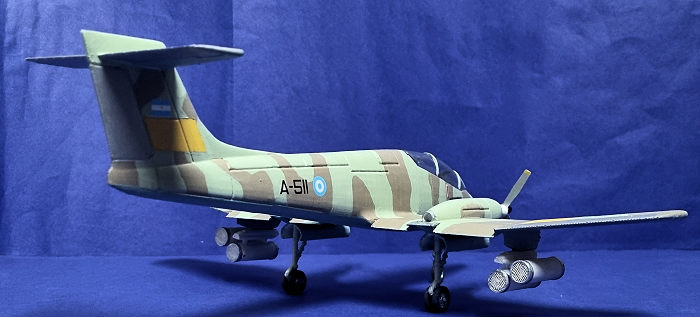 The
Aerocalcas set came with multiple options, but I chose to paint this aircraft as
A-511 from Carlos Tomba during Malvinas. This is the same option Kinetic chose
to give us on their kit. Colour wise, the shades of the fuselage were a light
brown and a very pale green/glue. Not wanting to experiment, I grabbed Kinetic’s
colour profile and searched for their equivalent colours in the Revell Aqua
range. The chose colours were 59 Duck Egg Blue and 89 Beige. But before painting
the fuselage, I added the yellow Malvinas band on the wings and empennage. The
ailerons on the horizontal and vertical stabilizes and wings were painted in
Revell 90, to simulate the natural metal of the original scheme. Once I had
masked all that, I painted the main colours. Undersides were painted Revell 49
Light Blue. I then glossed the model and applied the decals, which needed no
Microsol coats to settle into the panel lines, though some was brushed to give
them some help. I then matt coated the plane.
The
Aerocalcas set came with multiple options, but I chose to paint this aircraft as
A-511 from Carlos Tomba during Malvinas. This is the same option Kinetic chose
to give us on their kit. Colour wise, the shades of the fuselage were a light
brown and a very pale green/glue. Not wanting to experiment, I grabbed Kinetic’s
colour profile and searched for their equivalent colours in the Revell Aqua
range. The chose colours were 59 Duck Egg Blue and 89 Beige. But before painting
the fuselage, I added the yellow Malvinas band on the wings and empennage. The
ailerons on the horizontal and vertical stabilizes and wings were painted in
Revell 90, to simulate the natural metal of the original scheme. Once I had
masked all that, I painted the main colours. Undersides were painted Revell 49
Light Blue. I then glossed the model and applied the decals, which needed no
Microsol coats to settle into the panel lines, though some was brushed to give
them some help. I then matt coated the plane.
The best moment in any kit is to see it on its wheels. I glued the landing gear, propellers and rocket pods, waited for the glue to dry, turned it over, and added the vacuform canopy.
| CONCLUSIONS |
The kit is easy to assemble, and is a good starting point for scratch build improvements. However, the Kinetic kit is by far superior and doesn´t need any aftermarket. Buy the 3d printed version if you’re short on money.
Francisco Santoro
25 July 2023
Copyright ModelingMadness.com. All rights reserved. No reproduction in part or in whole without express permission from the editor.
If you would like your product reviewed fairly and fairly quickly, please contact the editor or see other details in the Note to Contributors.